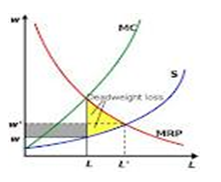The antitrust laws were created to enhance competition in the market. The law provides equal opportunities to all firms in the market, and regulates firms which develop strategies to hinder other firms from competing with them. The government aims at creating competition in the market so that firms can provide good quality products.
At the same time, these products should be given reasonable prices. This law protects firms and consumers too. Companies that do not comply with the provisions of these laws risk being sued and fined (Hylton, 2003).
Wal-Mart is an example of a company that has been reported to contravene the provisions of the antitrust laws. In many occasions, the company has experienced lawsuits in protest to a contravention with antitrust laws.
Wal-Mart has established retail stores and has dominated the US market. The firm has the characteristics of a monopsonist. A monopsonist refers to a situation where a single firm dictates the supply of products in the market. In such a situation, only one buyer seeks the products of several suppliers.
This gives the monopsonist the opportunity to dictate the market by offering low prices to suppliers (Besanko, 2011). A monopsonist operates at a point where marginal cost (MC) is equal to marginal revenue (MRp).
Therefore, the firm gets extraordinary profits because the demand is equivalent to the aggregate demand of supply. From the diagram below, it is evident that monopsonist gets abnormal profits because the labor demand is higher while the wage price is low.

Source: Haworth (n.d.).
Wal-Mart has been accused of applying the strategies of a monopsonist despite the fact that many similar firms exist in the market. For example, Coca-Cola Company has been forced by Wal-Mart to sell its products at very low prices.
Since Wal-Mart has the capacity to buy many products from Coca-Cola, the company has developed the strategy to offer low prices. Wal-Mart has also been accused of offering low wages to the workers. The company has employed many people and has taken advantage of being a top employer by offering very low wages.
This has made the employees of the company strike. Labor unions have complained about the low wages offered to workers by the firm (Lynn, 2006).
In 2005, Wal-Mart and Netflix colluded to create a monopoly in the DVD market. The two companies had developed a strategy to divide the market for DVDs. This was done to reduce competition in the market. The agreement was that Wal-Mart would not rent DVDs through the online channels.
This would offer Netflix the opportunity to sell DVDs in the market. This strategy was adopted when Blockbuster Company started to sell DVDs through online systems. The strategy developed by Wal-Mart and Netflix would make Netflix the sole marketer of DVDs.
This would discourage any other company in the industry. As such, suppliers of DVDs would be influenced to offer their products at low prices. Netflix started to offer competitive prices to its subscribers.
This aimed at driving competitors out of the market. The two companies were sued and found guilty of contravening the antitrust laws. The two companies were fined $40 million (Bloomberg News, 2010).
In conclusion, it is worth mentioning that antitrust laws were developed to protect companies from unfair business conduct. The laws give opportunities to firms to exploit the market with no restrictions from any single company.
A free market environment has been encouraged to create competition. Wal-Mart continues to practice unfair business, and this has made the company be fined for failing to adhere to the antitrust laws.
Reference List
Besanko, D. (2011). Microeconomics. Hoboken, N.J: Wiley.
Bloomberg News (2010). Antitrust suit against Netflix and Wal-Mart is given class-action status. Web.
Haworth, B. (n.d.). Monopsony. Web.
Hylton, K. N. (2003). Antitrust law: Economic theory and common law. New York: Cambridge University Press.
Lynn, B. C. (2006). The Case for Breaking up Wal-Mart. Web.